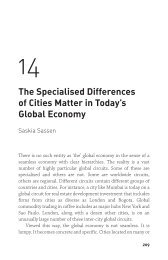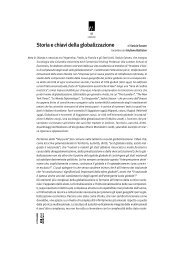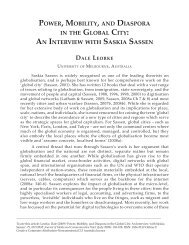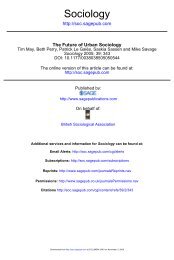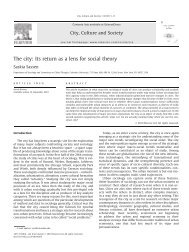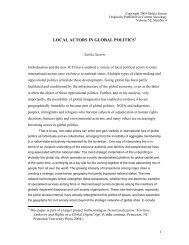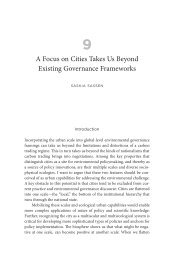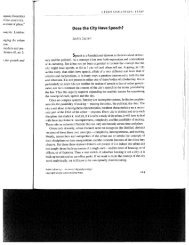Cities in Today's Global Age: An exploration of the ... - Saskia Sassen
Cities in Today's Global Age: An exploration of the ... - Saskia Sassen
Cities in Today's Global Age: An exploration of the ... - Saskia Sassen
You also want an ePaper? Increase the reach of your titles
YUMPU automatically turns print PDFs into web optimized ePapers that Google loves.
A second logic expla<strong>in</strong><strong>in</strong>g <strong>the</strong> ongo<strong>in</strong>g advantages <strong>of</strong> spatial<br />
agglomeration has to do with <strong>the</strong> complexity and specialisation<br />
level <strong>of</strong> central functions. These rise with globalisation and with<br />
<strong>the</strong> added speed that <strong>the</strong> new icts allow. As a result global firms and<br />
global markets <strong>in</strong>creas<strong>in</strong>gly need to buy <strong>the</strong> most specialised legal,<br />
account<strong>in</strong>g, consult<strong>in</strong>g and o<strong>the</strong>r such services. These service firms<br />
get to do some <strong>of</strong> <strong>the</strong> most difficult and speculative work. To do this<br />
work <strong>the</strong>y benefit from be<strong>in</strong>g <strong>in</strong> complex environments that function<br />
as knowledge centres because <strong>the</strong>y conta<strong>in</strong> multiple o<strong>the</strong>r specialised<br />
firms and high level pr<strong>of</strong>essionals with worldwide experience. <strong>Cities</strong><br />
are such environments—with <strong>the</strong> network <strong>of</strong> global cities <strong>the</strong> most<br />
significant <strong>of</strong> <strong>the</strong>se environments, but a grow<strong>in</strong>g number <strong>of</strong> o<strong>the</strong>r<br />
cities develop<strong>in</strong>g one or ano<strong>the</strong>r element <strong>of</strong> such environments. A<br />
third logic concerns <strong>the</strong> mean<strong>in</strong>g <strong>of</strong> <strong>in</strong>formation <strong>in</strong> an <strong>in</strong>formation<br />
economy. There are two types <strong>of</strong> <strong>in</strong>formation. One is <strong>the</strong> datum,<br />
which may be complex yet is standard knowledge: <strong>the</strong> level at which a<br />
stock market closes, a privatisation <strong>of</strong> a public utility, <strong>the</strong> bankruptcy<br />
<strong>of</strong> a bank. But <strong>the</strong>re is a far more difficult type <strong>of</strong> ‘<strong>in</strong>formation,’ ak<strong>in</strong><br />
to an <strong>in</strong>terpretation/evaluation/judgment. It entails negotiat<strong>in</strong>g a<br />
series <strong>of</strong> data and a series <strong>of</strong> <strong>in</strong>terpretations <strong>of</strong> a mix <strong>of</strong> data <strong>in</strong> <strong>the</strong><br />
hope <strong>of</strong> produc<strong>in</strong>g a higher order datum. Access to <strong>the</strong> first k<strong>in</strong>d<br />
<strong>of</strong> <strong>in</strong>formation is now global and immediate from just about any<br />
place <strong>in</strong> <strong>the</strong> highly developed world and <strong>in</strong>creas<strong>in</strong>gly <strong>in</strong> <strong>the</strong> rest <strong>of</strong><br />
<strong>the</strong> world thanks to <strong>the</strong> digital revolution. But it is <strong>the</strong> second type<br />
<strong>of</strong> <strong>in</strong>formation that requires a complicated mixture <strong>of</strong> elements—<br />
someth<strong>in</strong>g we might th<strong>in</strong>k <strong>of</strong> as—<strong>the</strong> social <strong>in</strong>frastructure for global<br />
connectivity. It is this which gives major f<strong>in</strong>ancial and/or bus<strong>in</strong>ess<br />
centres a lead<strong>in</strong>g edge. When <strong>the</strong> more complex forms <strong>of</strong> <strong>in</strong>formation<br />
needed to execute major <strong>in</strong>ternational deals cannot be gotten from<br />
exist<strong>in</strong>g data bases, no matter what one can pay, <strong>the</strong>n one needs <strong>the</strong><br />
social <strong>in</strong>formation loop and <strong>the</strong> associated de facto <strong>in</strong>terpretations<br />
and <strong>in</strong>ferences that come with bounc<strong>in</strong>g <strong>of</strong>f <strong>in</strong>formation among<br />
talented, <strong>in</strong>formed people. It is <strong>the</strong> importance <strong>of</strong> this <strong>in</strong>put that has<br />
given a whole new importance to credit rat<strong>in</strong>g agencies, for <strong>in</strong>stance.<br />
Part <strong>of</strong> <strong>the</strong> rat<strong>in</strong>g has to do with <strong>in</strong>terpret<strong>in</strong>g and <strong>in</strong>ferr<strong>in</strong>g. When<br />
this <strong>in</strong>terpret<strong>in</strong>g becomes ‘authoritative’ it becomes ‘<strong>in</strong>formation’<br />
available to all. The process <strong>of</strong> mak<strong>in</strong>g <strong>in</strong>ferences/<strong>in</strong>terpretations <strong>in</strong>to<br />
‘<strong>in</strong>formation’ takes quite a mix <strong>of</strong> talents and resources.<br />
In brief, <strong>the</strong> density <strong>of</strong> central places provides <strong>the</strong> social<br />
connectivity which allows a firm or market to maximise <strong>the</strong> benefits<br />
<strong>of</strong> its technological connectivity. <strong>Cities</strong> can generate k<strong>in</strong>ds <strong>of</strong><br />
‘knowledge,’ both formal and <strong>in</strong>formal, that go beyond <strong>the</strong> sum <strong>of</strong><br />
recognised knowledge actors (e.g. pr<strong>of</strong>essionals and pr<strong>of</strong>essional<br />
firms <strong>in</strong> <strong>the</strong> case <strong>of</strong> <strong>the</strong> economy). This is a type <strong>of</strong> immaterial capital I<br />
call ‘urban knowledge capital.’<br />
S YS T E M I C D E M A N D F O R G LO B A L C I T I E S<br />
A country’s global city (or cities) conta<strong>in</strong>s <strong>the</strong> needed<br />
resources and talents (<strong>of</strong>ten foreign firms and foreign pr<strong>of</strong>essionals)<br />
to bridge between global actors and national specifics. The results<br />
<strong>of</strong> a recent large–scale study <strong>of</strong> 75 major and m<strong>in</strong>or global economic<br />
centres, <strong>the</strong> MasterCard Worldwide Centres <strong>of</strong> Commerce (2008),<br />
makes it clear that as globalisation has expanded, <strong>the</strong> number <strong>of</strong><br />
<strong>the</strong>se centres has grown. We used 100 data po<strong>in</strong>ts organized <strong>in</strong>to<br />
sub–<strong>in</strong>dicators, which eventually were aggregated <strong>in</strong>to seven overall<br />
<strong>in</strong>dicators (Legal and Political Framework, Economic Stability, Ease <strong>of</strong><br />
Do<strong>in</strong>g Bus<strong>in</strong>ess, F<strong>in</strong>ancial Flow, Bus<strong>in</strong>ess Centre, Knowledge Creation<br />
and Information Flow, Liveability). This allows to identification <strong>of</strong> cities<br />
that function as global centres. We <strong>the</strong>n compared how cities perform<br />
critical functions that connect markets and commerce globally. The<br />
Index was developed by a panel <strong>of</strong> eight experts from different parts <strong>of</strong><br />
<strong>the</strong> world (<strong>in</strong>clud<strong>in</strong>g Peter Taylor and myself ) under <strong>the</strong> direction <strong>of</strong><br />
Dr. Yuwa Hedrick–Wong from MasterCard Worldwide.<br />
The tables presented here only cover <strong>the</strong> overall wcoc (Worldwide<br />
Centres <strong>of</strong> Commerce) Index and aggregate seven <strong>in</strong>dicators, focus<strong>in</strong>g<br />
particularly on Sydney and what are considered its ma<strong>in</strong> rivals:<br />
Melbourne, S<strong>in</strong>gapore, Hong Kong, Kuala Lumpur, and Shanghai.<br />
We have <strong>in</strong>cluded <strong>the</strong> top ten cities and a variable number <strong>of</strong> cities<br />
<strong>in</strong> each table, so as to <strong>in</strong>clude those cities ranked closely to each <strong>of</strong><br />
<strong>the</strong>se six cities. There is a rank<strong>in</strong>g that emerges from <strong>the</strong> aggregate<br />
data <strong>of</strong> all <strong>the</strong> <strong>in</strong>dicators and sub<strong>in</strong>dicators with some expected<br />
outcomes—London and New York at <strong>the</strong> top. But once we enter o<strong>the</strong>r<br />
variables, <strong>the</strong> results are far more distributed. This should suffice to<br />
illustrate a few key issues. One issue is <strong>the</strong> variability <strong>of</strong> rank<strong>in</strong>gs for<br />
each city across diverse criteria. It is also evident with <strong>the</strong> top–ranked<br />
cities (London and New York) <strong>in</strong> <strong>the</strong> overall study: nei<strong>the</strong>r is <strong>in</strong> <strong>the</strong><br />
top ten for all <strong>the</strong> sub–<strong>in</strong>dicators considered <strong>in</strong> <strong>the</strong> larger study. Such<br />
a rank<strong>in</strong>g system is one way <strong>of</strong> beg<strong>in</strong>n<strong>in</strong>g to understand <strong>the</strong> fact that<br />
we are deal<strong>in</strong>g with a networked platform for globalisation and this<br />
networked platform is more important than hav<strong>in</strong>g a s<strong>in</strong>gle ‘perfect’<br />
global city, or a very small number <strong>of</strong> <strong>the</strong>m.<br />
As globalisation expanded <strong>in</strong> <strong>the</strong> 1990s, it actually created a<br />
systemic demand for a grow<strong>in</strong>g number <strong>of</strong> global cities—<strong>the</strong>ir number<br />
grew and came to <strong>in</strong>clude more and more regions <strong>of</strong> <strong>the</strong> world. This<br />
demand for global cities cont<strong>in</strong>ues to grow even if many <strong>of</strong> <strong>the</strong>se cities<br />
are found want<strong>in</strong>g on critical issues.<br />
36 37




